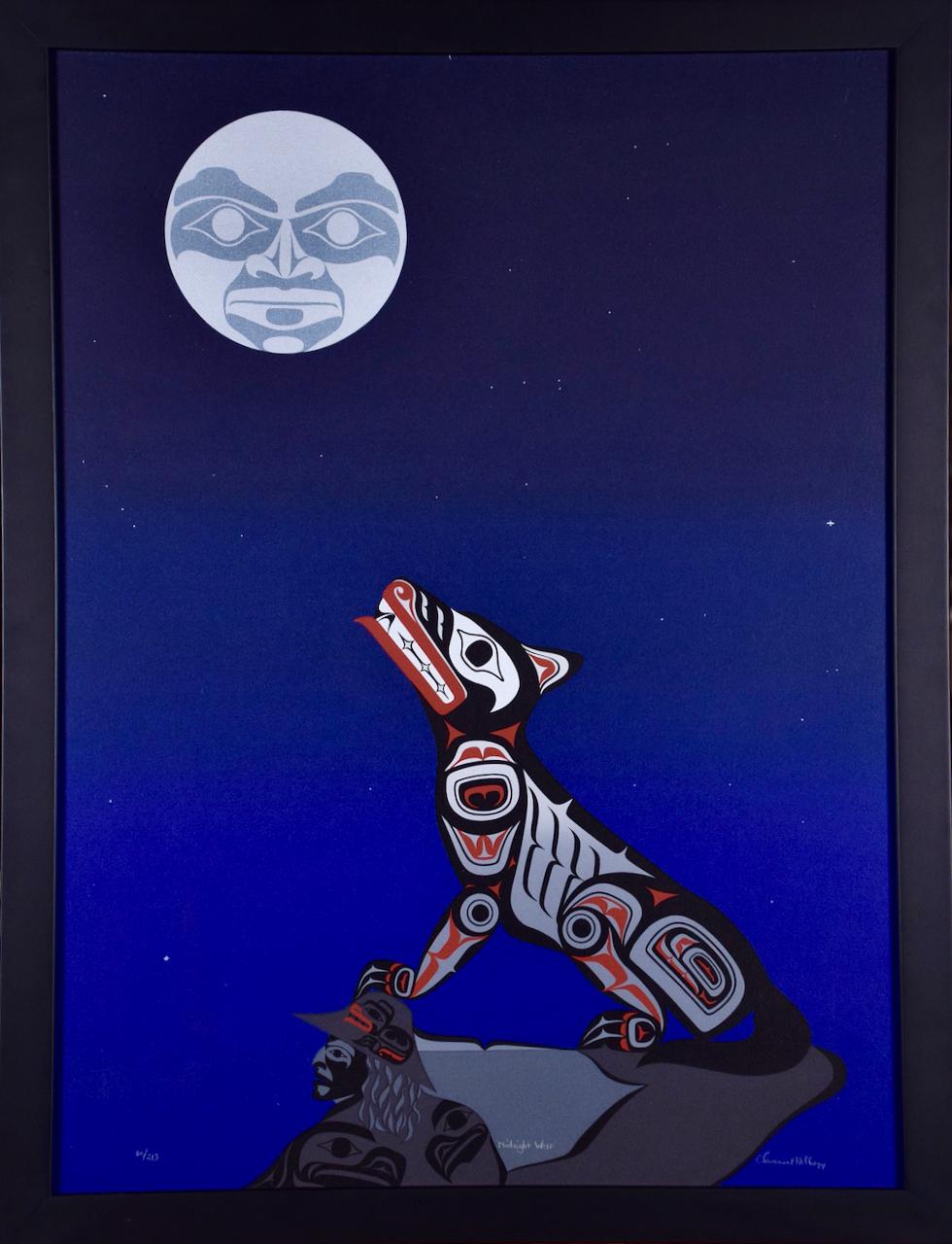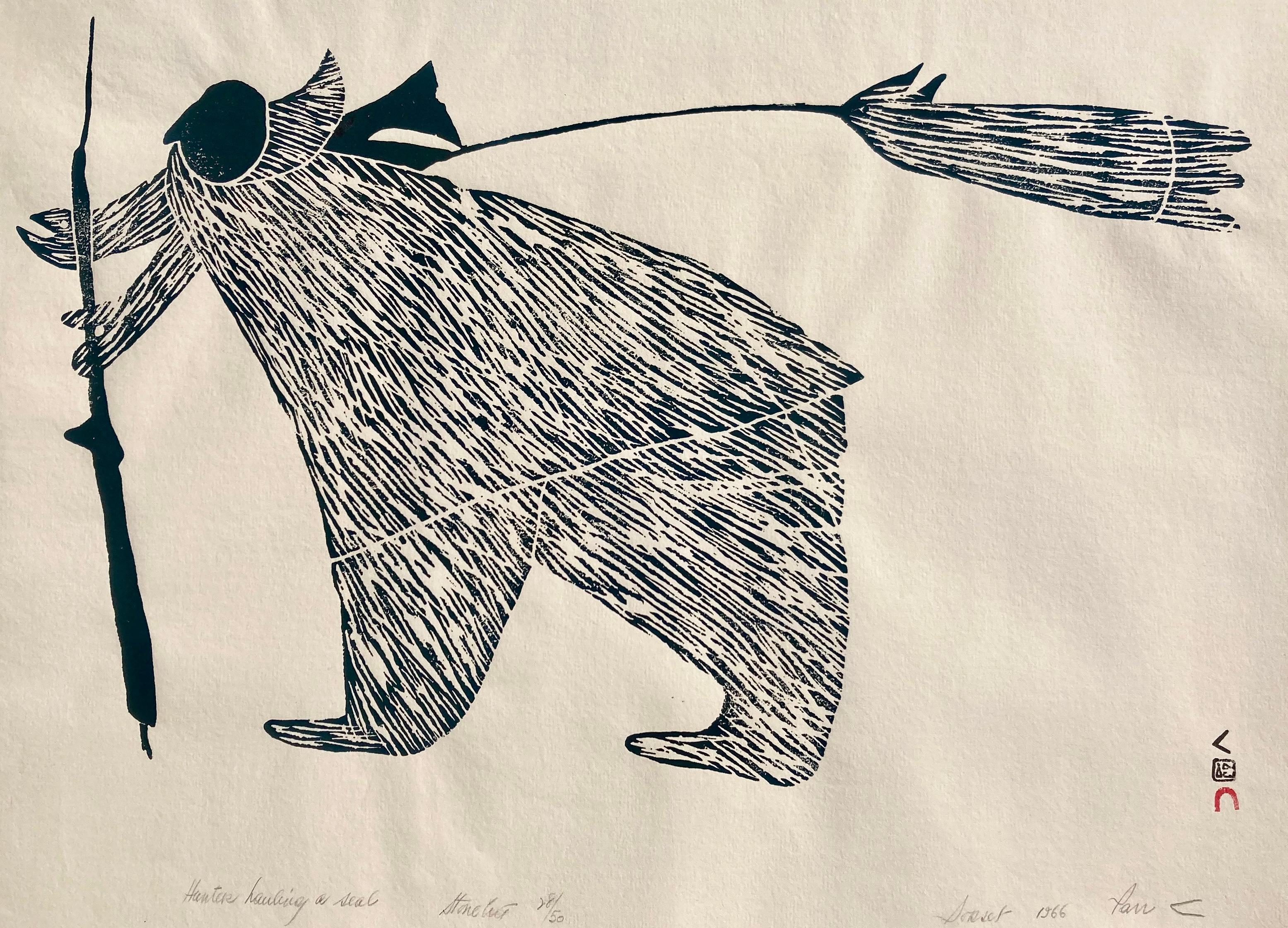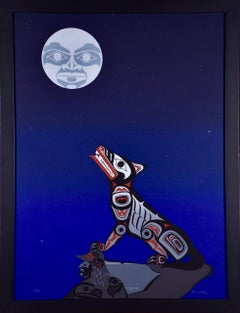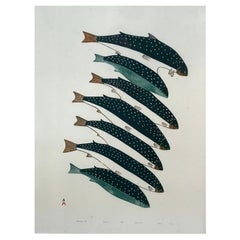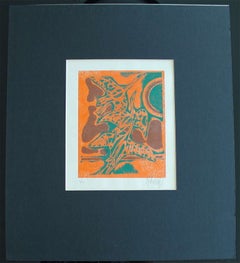Items Similar to The Protectress
Want more images or videos?
Request additional images or videos from the seller
1 of 12
Kakulu SaggiaktokThe Protectress1997
1997
$1,700
£1,288.07
€1,477.96
CA$2,392.17
A$2,629.66
CHF 1,382.03
MX$31,933.62
NOK 17,240.45
SEK 16,334.11
DKK 11,030.40
About the Item
This artwork titled "The protectress" 1997 is a original stone cut with stencil on thin paper by noted Canadian Inuit artist Kakulu Saggiaktok, 1940-2020. It is hand signed, titled, dated, described, located and numbered 17/50 in pencil by the artist. The subject size is 16.5 x 13 inches, sheet size is 18.5 x 23.75 inches, framed size is 25.75 x 30.85 inches. Custom framed in a metal frame, with dark grey backing. It is in excellent condition.
About the artist:
Kakulu Saggiaktok was born in 1940 on board the Hudson’s Bay Company supply ship, Nascopie. Her family had travelled from south Baffin Island to hunt and trap in the northern regions of the island. Kakulu was a child when she moved back to the Cape Dorset area.
Kakulu began to draw in the early 1960’s when the West Baffin Co-operative established its printmaking studios. Many of her images explore the theme of transformation, with animals blending into other animals, humans becoming animals and vice versa. This is a predominant subject in traditional Inuit folklore and Kakulu Saggiaktok mythology, where the natural and supernatural worlds were mediated by the shaman. Kakulu’s work is always imaginative and often playful and charming and much of her inspiration comes from her childhood memories of living on the land.
Kakulu’s mother was Ikayukta (deceased), also one of the early contributors to the annual print collections from Cape Dorset. Kakulu was married to Saggiaktok (deceased), who was a printmaker in the stonecut studio for many years.
Selected Museums:
Her work is held in several museums, including the Agnes Etherington Art Centre, the McMaster Museum of Art, the University of Michigan Museum of Art, the Montreal Museum of Fine Arts, the National Gallery of Canada, the Winnipeg Art Gallery, the Art Gallery of Greater Victoria, the Canada Council Art Bank, the National Museum of the American Indian, the Brunnier Art Museum, and the Amon Carter Museum of American Art.
- Creator:Kakulu Saggiaktok (1940 - 2020, Inuit, Canadian)
- Creation Year:1997
- Dimensions:Height: 25.75 in (65.41 cm)Width: 30.85 in (78.36 cm)Depth: 1.15 in (2.93 cm)
- Medium:
- Period:
- Condition:
- Gallery Location:San Francisco, CA
- Reference Number:Seller: sag/pro/011stDibs: LU666310576312
About the Seller
5.0
Platinum Seller
Premium sellers with a 4.7+ rating and 24-hour response times
Established in 1999
1stDibs seller since 2017
838 sales on 1stDibs
Typical response time: 1 hour
- ShippingRetrieving quote...Shipping from: San Francisco, CA
- Return Policy
Authenticity Guarantee
In the unlikely event there’s an issue with an item’s authenticity, contact us within 1 year for a full refund. DetailsMoney-Back Guarantee
If your item is not as described, is damaged in transit, or does not arrive, contact us within 7 days for a full refund. Details24-Hour Cancellation
You have a 24-hour grace period in which to reconsider your purchase, with no questions asked.Vetted Professional Sellers
Our world-class sellers must adhere to strict standards for service and quality, maintaining the integrity of our listings.Price-Match Guarantee
If you find that a seller listed the same item for a lower price elsewhere, we’ll match it.Trusted Global Delivery
Our best-in-class carrier network provides specialized shipping options worldwide, including custom delivery.More From This Seller
View AllSilent Hunter
Located in San Francisco, CA
This artwork titled "Silent Hunter" 2002 is an original color stonecut on beige Japan paper by noted Canadian/Inuit artist Kananginak Pootoogook, 1935-2010. It is hand signed, dated, titled, located, described and numbered 22/50 in pencil by the artist. The image size is 15 x 11.75 inches, framed size is 23.35 x 20 inches. Custom framed in a wooden dark green frame, with green matting. It is in excellent condition.
About the artist:
Kananginak Pootoogook was an Inuit sculptor and printmaker who lived in Cape Dorset, Nunavut, in Canada. He died as a result of complications related to surgery for lung cancer.
Pootoogook was born at a traditional Inuit camp called Ikerasak, near Cape Dorset, Nunavut (then in the Northwest Territories) to Josephie Pootoogook, leader of the camp, and Sarah Ningeokuluk. The family lived a traditional lifestyle hunting and trapping while living in an iglu in the winter and a sod house in the summer and did not move into their first southern style house until 1942. In 1957 Pootoogook married Shooyoo, moved to Cape Dorset and began work for James Houston.
Originally, Pootoogook did some carving, made prints and lithographs for other artists. At the same time he was a leader in setting up the West Baffin Eskimo Co-operative, the first Inuit owned co-op, now part of the Arctic Co-operatives Limited and served from 1959 until 1964 as the president. Although Kananginak had worked with his father, Josephie, in 1959, it was not until the 1970s that Kananginak began work as a full-time artist producing drawings, carvings and prints. According to Terry Ryan, former Co-op manager, Pootoogook was both influenced by and an admirer of the works of his uncle, photographer and historian Peter Pitseolak.
The World Wildlife Commission released a limited edition set in 1977 that included four of Pootoogook's images and in 1980 he was elected to the Royal Canadian Academy of Arts. In 1997 Pootoogook built a 6 ft (1.8 m) inukshuk in Cape Dorset for former Governor General of Canada, Roméo LeBlanc. The inukshuk was dismantled and shipped to Ottawa and with the assistance of his son, Johnny, it was rebuilt at Rideau Hall and unveiled on 21 June, National Aboriginal Day.
Pootoogook had several exhibitions and showings of his work. In 2010, he went to Vancouver for the 2010 Winter Olympics and to open a showing of his work at the Marion Scott Gallery. He also had a showing of his work, his first solo exhibition at a public institution, at the Museum of Inuit Art in Toronto from February to May 2010. He also received a 2010 National Aboriginal Achievement Award in the arts category from the National Aboriginal Achievement Foundation.
While working on his final, and unfinished, drawing of a Peterhead owned by his father, he was struck by coughing spells, which he declared was cancer. Along with his wife, Shooyoo, he flew to Ottawa, staying at the Larga Baffin home, and was diagnosed with lung cancer. In October 2010, he underwent surgery and did not recover. He died 23 November 2010 in Ottawa. The work of Kananginak Pootoogook is held in numerous collections and museums, includingThe McCord Museum, the Dallas Museum of Art, Musee National des Baux Arts...
Category
Late 20th Century Other Art Style Figurative Prints
Materials
Other Medium
The Drummer
Located in San Francisco, CA
This artwork titled "The Drummer" 1993 is an original color lithograph on Wove paper by noted Canadian/Inuit artist Kananginak Pootoogook, 1935-2010. It is hand signed, dated, titled, located, described and numbered 31/50 in pencil by the artist. The image size is 22 x 15.5 inches, sheet size is 30 x 22.5 inches, framed size is 39.5 x 31.5 inches. Custom framed in a dark wood frame, with off white backing. The artwork is in excellent condition, the frame has minor restorations and very light dents, barely visible.
About the artist:
Kananginak Pootoogook was an Inuit sculptor and printmaker who lived in Cape Dorset, Nunavut, in Canada. He died as a result of complications related to surgery for lung cancer.
Pootoogook was born at a traditional Inuit camp called Ikerasak, near Cape Dorset, Nunavut (then in the Northwest Territories) to Josephie Pootoogook, leader of the camp, and Sarah Ningeokuluk. The family lived a traditional lifestyle hunting and trapping while living in an iglu in the winter and a sod house in the summer and did not move into their first southern style house until 1942. In 1957 Pootoogook married Shooyoo, moved to Cape Dorset and began work for James Houston.
Originally, Pootoogook did some carving, made prints and lithographs for other artists. At the same time he was a leader in setting up the West Baffin Eskimo Co-operative, the first Inuit owned co-op, now part of the Arctic Co-operatives Limited and served from 1959 until 1964 as the president. Although Kananginak had worked with his father, Josephie, in 1959, it was not until the 1970s that Kananginak began work as a full-time artist producing drawings, carvings and prints. According to Terry Ryan, former Co-op manager, Pootoogook was both influenced by and an admirer of the works of his uncle, photographer and historian Peter Pitseolak.
The World Wildlife Commission released a limited edition set in 1977 that included four of Pootoogook's images and in 1980 he was elected to the Royal Canadian Academy of Arts. In 1997 Pootoogook built a 6 ft (1.8 m) inukshuk in Cape Dorset for former Governor General of Canada, Roméo LeBlanc. The inukshuk was dismantled and shipped to Ottawa and with the assistance of his son, Johnny, it was rebuilt at Rideau Hall and unveiled on 21 June, National Aboriginal Day.
Pootoogook had several exhibitions and showings of his work. In 2010, he went to Vancouver for the 2010 Winter Olympics and to open a showing of his work at the Marion Scott Gallery. He also had a showing of his work, his first solo exhibition at a public institution, at the Museum of Inuit Art in Toronto from February to May 2010. He also received a 2010 National Aboriginal Achievement Award in the arts category from the National Aboriginal Achievement Foundation.
While working on his final, and unfinished, drawing of a Peterhead owned by his father, he was struck by coughing spells, which he declared was cancer. Along with his wife, Shooyoo, he flew to Ottawa, staying at the Larga Baffin home, and was diagnosed with lung cancer. In October 2010, he underwent surgery and did not recover. He died 23 November 2010 in Ottawa. The work of Kananginak Pootoogook is held in numerous collections and museums, includingThe McCord Museum, the Dallas Museum of Art, Musee National des Baux Arts...
Category
Late 20th Century Other Art Style Figurative Prints
Materials
Lithograph
Intrepid Caribou
Located in San Francisco, CA
This artwork titled "Intrepid Caribou" 2002 is an original color stone cut on Japan paper by noted Canadian/Inuit artist Kananginak Pootoogook, 1935-2010. It is hand signed, dated, titled, located, described and numbered 22/50 in pencil by the artist. The image size is 18.5 x 12.5 inches, sheet size is 23 x 16 inches, framed size is 24.85 x 29.65 inches. Custom framed in a black metal frame, with black matting. It is in excellent condition.
About the artist:
Kananginak Pootoogook was an Inuit sculptor and printmaker who lived in Cape Dorset, Nunavut, in Canada. He died as a result of complications related to surgery for lung cancer.
Pootoogook was born at a traditional Inuit camp called Ikerasak, near Cape Dorset, Nunavut (then in the Northwest Territories) to Josephie Pootoogook, leader of the camp, and Sarah Ningeokuluk. The family lived a traditional lifestyle hunting and trapping while living in an iglu in the winter and a sod house in the summer and did not move into their first southern style house until 1942. In 1957 Pootoogook married Shooyoo, moved to Cape Dorset and began work for James Houston.
Originally, Pootoogook did some carving, made prints and lithographs for other artists. At the same time he was a leader in setting up the West Baffin Eskimo Co-operative, the first Inuit owned co-op, now part of the Arctic Co-operatives Limited and served from 1959 until 1964 as the president. Although Kananginak had worked with his father, Josephie, in 1959, it was not until the 1970s that Kananginak began work as a full-time artist producing drawings, carvings and prints. According to Terry Ryan, former Co-op manager, Pootoogook was both influenced by and an admirer of the works of his uncle, photographer and historian Peter Pitseolak.
The World Wildlife Commission released a limited edition set in 1977 that included four of Pootoogook's images and in 1980 he was elected to the Royal Canadian Academy of Arts. In 1997 Pootoogook built a 6 ft (1.8 m) inukshuk in Cape Dorset for former Governor General of Canada, Roméo LeBlanc. The inukshuk was dismantled and shipped to Ottawa and with the assistance of his son, Johnny, it was rebuilt at Rideau Hall and unveiled on 21 June, National Aboriginal Day.
Pootoogook had several exhibitions and showings of his work. In 2010, he went to Vancouver for the 2010 Winter Olympics and to open a showing of his work at the Marion Scott Gallery. He also had a showing of his work, his first solo exhibition at a public institution, at the Museum of Inuit Art in Toronto from February to May 2010. He also received a 2010 National Aboriginal Achievement Award in the arts category from the National Aboriginal Achievement Foundation.
While working on his final, and unfinished, drawing of a Peterhead owned by his father, he was struck by coughing spells, which he declared was cancer. Along with his wife, Shooyoo, he flew to Ottawa, staying at the Larga Baffin home, and was diagnosed with lung cancer. In October 2010, he underwent surgery and did not recover. He died 23 November 2010 in Ottawa. The work of Kananginak Pootoogook is held in numerous collections and museums, includingThe McCord Museum, the Dallas Museum of Art, Musee National des Baux Arts...
Category
Late 20th Century Other Art Style Figurative Prints
Materials
Other Medium
Price Upon Request
Sea Spirit
Located in San Francisco, CA
This artwork titled "Sea Spirit" 1965 is an original stonecut on thin paper by Eskimo artist Egevadluq (Eegyvudluk) Ragee, 1920-1983. It is hand signed, titled, dated, described and numbered 20/50 in pencil by the artist. With the blind stamp of the artist at the lower right corner. It is in excellent condition. it has a minor thin crease at the middle center, at the edge of the sheet, barely visible, see picture #4
About the artist:
Eegyvudluk Ragee was the oldest child born to Pamiaktok and Sorisolutu at the small campsite of Ikarasak, on the southern tip of Baffin Island in 1920.
When Egevadluq travelled to Cape Dorset (Kinngait) to trade for supplies, she would buy graphite pencil and paper from the West Baffin Eskimo Co-operative. Her early works filled entire sheets of paper, mythical creatures, bird-animal-human transformations, and images from reality - all randomly intermingled . By the mid-1960s, Eegyvudluk was using wax crayons, or coloured felt pens on paper.
In 1967, improved housing in Cape Dorset resulted in the Inuit abandoning most of the campsites. Eegyvudluk moved into the settlement, and by the early 1970s, explored the use of arcrylic washes, on which she drew her well-known figures and birds.
"I started drawing because I was 'tususkuk' (when I saw other people doing it, I wanted to do the same things)...When I start to make a drawing, I have a picture in my mind, but when I try to put that picture on paper, my hands won't do what my mind wants. When I have the picture in my head, I can't get it out by my hands. Sometimes I find it hard to draw when my children are in the house; I find it hard to think with so much noise around me. I make the kids go outside." Eegyvudluk, Cape Dorset Print Catalogue, 1978.
Exhibitions
Alaska Eskimo Dolls/Inuit Prints, Provincial Museum of Alberta, sponsored by the Alaska State Council on the Arts
ART ESKIMO, Galerie de France
Art Inuit, Presented by l'Iglou Art Esquimau, Douai at Galerie Akenaton
Art Inuit: Autour de la Collection de Cape Dorset 1991, Presented by l'Iglou Art Esquimau, Douai at Le Colombier
Art/Facts, McMaster Art Gallery
Art/Facts, McMaster Art Gallery
Canadian Eskimo Art...
Category
Mid-20th Century Folk Art Figurative Prints
Materials
Other Medium
Fish Become Birds
Located in San Francisco, CA
This artwork titled "Fish Become Birds" 1999 is an original colors stonecut on thin tissue paper by Canadian/ Inuit artist Kavavaow (Kavavau) Mannomee, b.1958. It is hand signed, titled, located, dated, described and numbered 4/50 in pencil by the artist. The subject size is 16 x 23.25 inches, sheet size is 24.5 x 29 inches. It is in excellent condition.
About the artist:
Qavavau born in Brandon, Manitoba in 1958 where his mother, Paunichea, was hospitalized for treatment of tuberculosis. He returned to Cape Dorset...
Category
Late 20th Century Other Art Style Animal Prints
Materials
Other Medium
Winter Dream
By Pudlo Pudlat
Located in San Francisco, CA
This artwork titled "Winter Dream" 1989 is an original stonecut on thin tissue paper by noted Canadian/Inuit artist Pudlo Pudlat, 1916-1992. It is hand signed, titled, dated. describ...
Category
Late 20th Century Other Art Style Animal Prints
Materials
Other Medium
You May Also Like
Midnight Wolf: A Limited Edition Clarence Mills Signed Haida Inuit Print
Located in Alamo, CA
"Midnight Wolf" is a framed signed limited edition abstract inuit native people's work by Northwest Coast Haida artist Clarence Mills. The print depicts a st...
Category
Late 20th Century Abstract Animal Prints
Materials
Woodcut
HUNTER HAULING A SEAL - IMPORTANT INUIT PRINT -
Located in Santa Monica, CA
PARR (1893-1969) KINNGAIT (CAPE DORSET)
HUNTER HAULING A SEAL, 1966 #2,
Stonecut, signed, titled numbered 28/50 Dorset 1966. Image 14 x 22 ¼. Full sheet ...
Category
1960s Other Art Style Animal Prints
Materials
Stone
$2,800 Sale Price
20% Off
Kakulu Saggiaktok Migrating Fish Stonecut Art Canada Baffin Dorset Inuit Culture
Located in Hyattsville, MD
THIS WILL BE SHIPPED IN TUBE, NO FRAME IS INCLUDED. If you want the frame (35x41) Please inquire before purchase freighting would be required.
Artwork 24" x 30" Stonecut (Lithograph-like) on Paper. Pencil signed and marked by artist along bottom. Edition 47/50.
Stonecut is an elegant process and Cape Dorset printmakers have refined it to a fine art. The first step is tracing the original drawing and applying it to the smooth surface of the prepared stone. Using india ink, the stonecutter delineates the drawing on the stone and then cuts away the areas that are not to appear in print, leaving the uncut areas raised, or in relief. The raised area is inked using rollers...
Category
1990s Canadian Organic Modern Prints
Materials
Paper
$2,000 Sale Price
20% Off
Inuit-Inspired Silkscreen Print, "Canada Suite Series", Ed. 6/20
By Yargo De Lucca
Located in Surfside, FL
Original serigraph silkscreen print by German/Canadian expressionist Yargo de Lucca (1925-2008) from the “Canada Suite” series, a hand-signed and numbered Inuit-inspired silkscreen p...
Category
1970s Contemporary Abstract Prints
Materials
Lithograph
Inuit-Inspired Silkscreen Print, "Canada Suite Series", Ed. 6/20
By Yargo De Lucca
Located in Surfside, FL
Original serigraph silkscreen print by German/Canadian expressionist Yargo de Lucca (1925-2008) from the “Canada Suite” series, a hand-signed and numbered Inuit-inspired silkscreen p...
Category
1970s Contemporary Abstract Prints
Materials
Lithograph
Inuit-Inspired Silkscreen Print, "Canada Suite Series", Ed. 6/22
By Yargo De Lucca
Located in Surfside, FL
Original serigraph silkscreen print by German/Canadian expressionist Yargo de Lucca (1925-2008) from the “Canada Suite” series, a hand-signed and numbered Inuit-inspired silkscreen p...
Category
1970s Contemporary Abstract Prints
Materials
Lithograph
